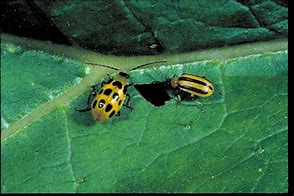The Problem
- Cucumber beetles damage crops in at least three ways:
- Their feeding directly stunts plants, which reduces fruit set.
- They transmit bacterial wilt disease and mosaic virus.
- They scar the fruit which makes it generally unappetizing.
- Striped cucumber beetles generally limit their damage to cucurbit crops (including cucumbers, squash, zucchini and melons), while spotted cucumber beetles can feed on over 200 different types of plants. Green beans, lettuce, onions, beets, peas and some cabbages can also be a favored plant for them.


Appearance: There are two types of these pests:
- The western spotted cucumber beetle and the striped cucumber beetle.
- The striped cucumber beetle


Signs of damage
- The larvae live in the soil where they feed on roots, and bore into the base of stems. Plants infested by the larvae will be stunted and unhealthy looking.
- Adults eat small holes in the leaves and flowers of many crops.
Life cycle
- Cucumber beetles overwinter as fertilized adults and are active beginning in early spring.
- Adults lay eggs at the base of plants.
- Eggs hatch in 7 to 10 days, and
- Larvae feed in roots for about 3 weeks before pupating in the soil.
- Adults emerge in 2 weeks and begin feeding on pollen.
- It takes 30 to 60 days to complete a life cycle.
- There are two generations a year.
Controls
- Sanitation
- Monitoring for plants with infested roots or stems and digging them out for disposal is a highly effective early control.
- Any cucurbit crop, whether visibly infested or not, should be dug out and disposed of when it’s done fruiting.
- Tilling the soil in the late fall will expose adult beetles to harsh winter conditions and can help reduce their adult breeding population in the spring.
- Crop rotation Don’t make it easy for the beetles to find your crops.
- Planting from starts rather than seeds in the soil reduces the young plants’ exposure.
- Beneficial nematodes. Specifically the Hb type (Heterohabditis bacteriophora in case you’re ever on Jeopardy) preys on cucumber beetles.
- Row covers prevent the adult beetles from getting to your plants in order to feed or lay their eggs.
- Sticky traps can also help control adult beetles, but they’re a “broad- spectrum” control and will also catch beneficial insects.
